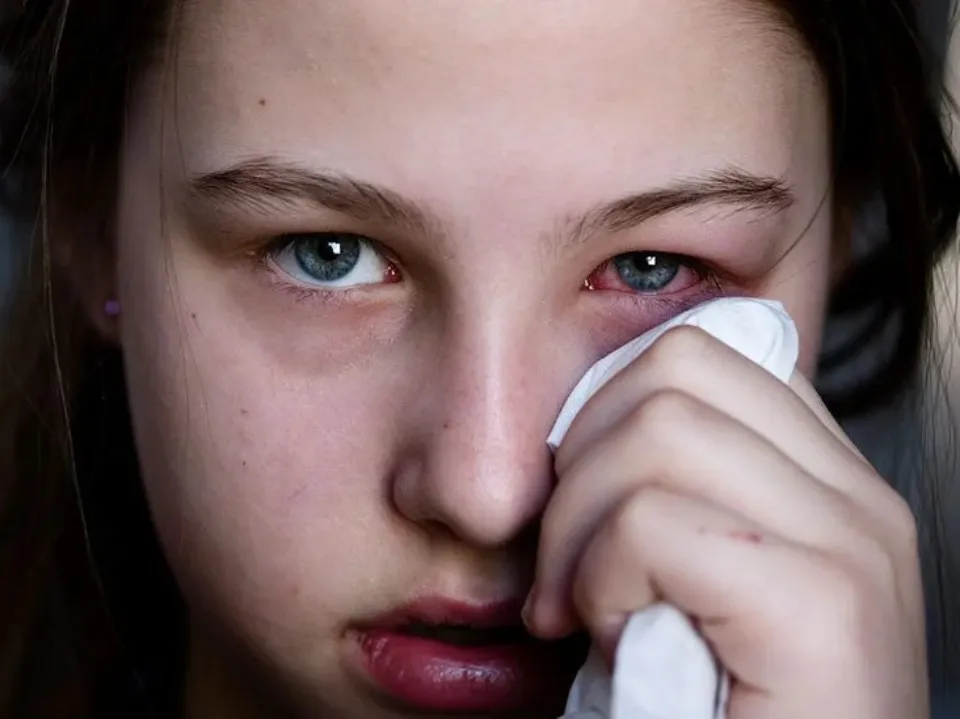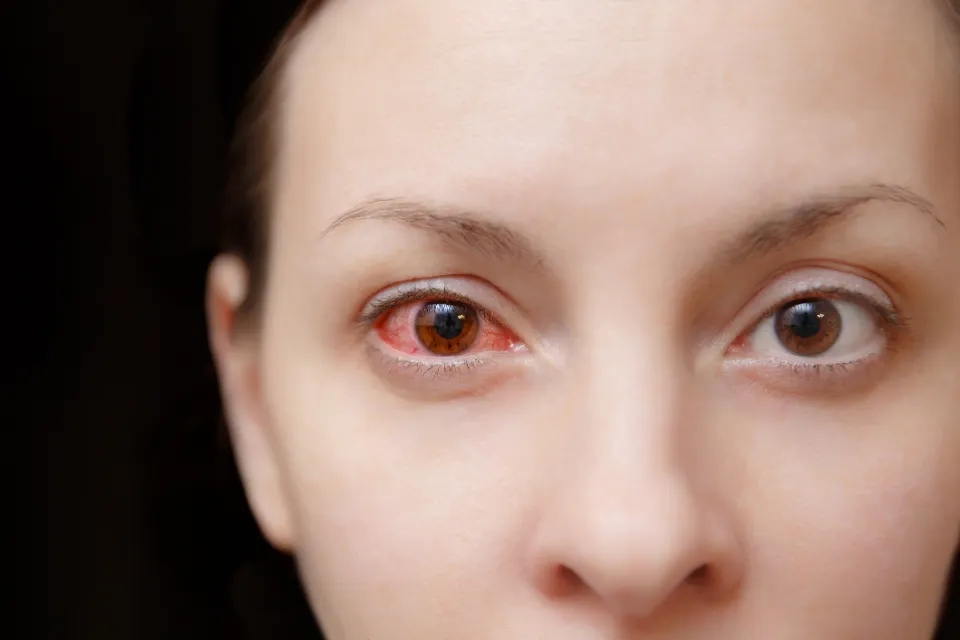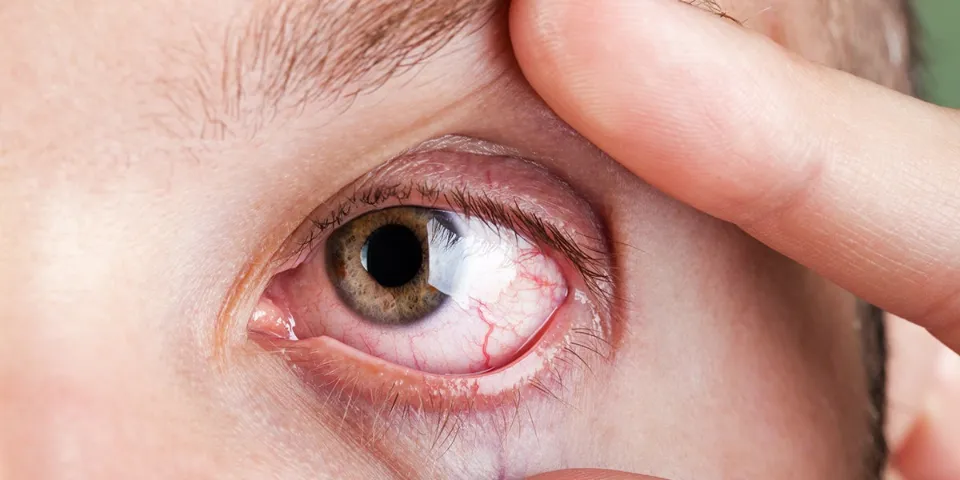
Can You Get Pink Eye from a Swimming Pool – How to Avoid?
Everyone is thinking about taking a dip in the pool as the breezy spring season is quickly coming to an end and the weather is warming up in preparation for the impending summer.
However, chlorine in swimming pool water is ineffective at eliminating viruses and does not stop the spread of this infection, which can result in pink eye.
As a result, you should avoid swimming while suffering from pink eye and seek treatment before visiting a public pool!
What is Pink Eye?

Pink eye, you may be surprised to learn, is not the real name of the infection. Is that a literal translation of conjunctivitis? And, conjunctivitis is “an inflammation or swelling of the conjunctiva…the thin transparent layer of tissue that lines the inner surface of the eyelid and covers the white part of the eye.” Generally, the eye white part of the eye will be “pink” and may be swollen, crusty from discharge, and/ or sensitive to light.
It may affect both eyes or just one. It may or may not be contagious. Or it might not be bacterial. An allergic reaction might trigger its onset. Or not.
The short answer is that you can get pink eye from a swimming pool, but in that case, the chlorine in the pool is likely what is causing the allergic reaction. Get in the habit of wearing goggles in the pool if you are prone to allergies.
And avoid the pool if you do have pink eye. If you are contagious, the chlorine will make the irritation worse, and if you touch anything after wiping the water from your eyes, you could spread the infection through towels or other objects.
Can You Swim With Pink Eye If You Wear Goggles?

Goggles are advised to prevent water and chlorine from entering eyes in general, but they might not be able to stop an infection from infecting more people or from spreading.
Additionally, if another swimmer mistakenly claimed a sick swimmer’s goggles as their own and wore them around their eyes, it could quickly result in a second infection.
Sunglasses or any other type of eye protection won’t likely be sufficient to stop an infection from spreading.
Why You Should Avoid Swimming With Pink Eye
Swimming while suffering from pink eye can lead to a number of issues. Until your infection has resolved, it’s usually best to just avoid swimming due to worsening symptoms and a higher risk of infection transmission to other swimmers.
Here are a few of the biggest reasons why avoiding the water is important when you have pink eye:

Other Swimmers Can Become Infected
You should avoid using swimming pools if you have pink eye, according to the CDC in the United States. Even in chlorinated swimming pools, bacterial and viral conjunctivitis can spread to other people because of their high contagiousness. And, as we’ll see in a moment, chlorine can make the situation worse.
Sharing items by the pool, such as towels, sunscreen, and goggles, can spread pink eye during water-related activities or even just in general.
Chlorine Can Increase Discomfort
Conjunctivitis can make any discomfort worse because chlorine is a chemical irritant. Additionally, it removes the protective tear film that keeps your eyes moist and clear. According to the American Academy of Ophthalmology, chlorine can cause feelings of grittiness, dry eye, redness, and blurred vision by disrupting the tear film in the eyes, leaving them open to chemicals and bacteria in the water.
However, other contaminants such as human, bird, and animal waste, insects, and other debris frequently find their way into outdoor swimming pools in addition to chlorine. As it is, eye infections are a disaster waiting to happen because eyes are already extremely sensitive to these factors.
Despite being a less severe irritant than chlorine, salt in saltwater pools can still make people uncomfortable and cause red eyes.
Fresh Water Adds Exposure to Bacteria
Going swimming in a nearby lake can also be risky for your eyes, especially if you have pink eye, in addition to chlorine and saltwater pools.
The susceptibility of an already infected eye to further infections from bacteria and other pathogens found in lakes may increase.
When and How to Treat Pink Eye?

Depending on the type of pink eye you or your child may have, the treatment will vary. And in order to do that, you might need to see a doctor, who might then recommend nonsteroidal anti-inflammatory drugs and/or a topical steroid eye drop. It may be necessary to use antibiotic eye drops if there is a bacterial infection. If it is viral, you are essentially doomed and must focus on comfort while the virus takes its course.
Read More: Pros And Cons Of Lumify Eye Drops
Since bacterial and viral infections are extremely contagious, frequent and thorough hand washing should always be practiced to reduce the effects. To be on the safe side, you should also throw away your mascara and change your face cloths and towels every day (possibly even your pillowcase).
When is It Safe to Swim Again?
You run the risk of having a longer-lasting infection, experiencing more discomfort, and possibly infecting other swimmers if you swim while you have pink eye. When swimming, simple precautions are insufficient to prevent pink eye.
So how long must pass before you can swim once more? It can take from a few days to a few weeks for conjunctivitis to clear up, and each person’s pink eye conditions and treatments may differ. If you want to be sure it’s safe to go swimming or to join in on the fun at a pool party, speak with your eye doctor before making any more splashes.
Care for your pink eye as much as you can at home in the interim. Warm compresses and eye drops can help with bacterial conjunctivitis symptoms, and cool compresses are advised to help with itching brought on by viral and allergic conjunctivitis.

What Else Can I Catch from a Public Pool?
By practicing and teaching others about proper pool hygiene, you can avoid getting cooties from the water. The irritating byproducts produced when urine, perspiration, and cosmetics combine with chlorine can be reduced by taking a shower before swimming.
Unfortunately, pool-related illnesses do occur. Some of the most common are:
- Diarrhea
This one originates from the parasite Cryptosporidium. It enters the pool through feces. not just the significant blowouts. It might originate from small amounts of an infected person. The bad news is that it has a long lifespan independent of its host and is resistant to chlorine.
- Rashes
One such rash is the hot tub rash, a rash that typically appears in areas of the body covered by your bathing suit. In a hot tub, you will be more susceptible to it because chlorine breaks down more quickly than in cold water. Chlorine does, however, kill the germ that causes it. Limit the amount of time you spend in a hot tub, wash your bathing suits after, and take a shower with soap. It usually goes away on its own in a few days, which is good news.

- Ear Infections
When contaminated water enters the ear canal, swimmer’s ear develops, which is a very common pool-related infection. Antibiotic ear drops are typically used to treat it because it can be extremely painful.
Contrary to popular belief, it is not the same as a middle ear infection. If you can wiggle the outer ear without pain or discomfort then it is probably not swimmer’s ear.
After swimming, make sure to drain all the water out of your ears and keep them as dry as you can. Keep your ear wax in place; it helps to prevent infection of the ear canal.
- Respiratory Infections
Are you familiar with the Legionnaires’ Disease? You can get Legionella from contaminated steam or mist, which is what caused it. It is more likely to affect people over 50, those with weakened immune systems, those with ongoing lung conditions, and smokers.
Conclusion
Pink or even red eyes are a very common symptom of allergies, which are also frequently accompanied by itching. In addition to a common clear or off-white discharge, the eye whites may even appear swollen. Topical over-the-counter antihistamines are typically effective in mild cases, but more severe cases may require topical steroid drops that must be prescribed.
FAQs
Can Poop Water Cause Pink Eye?
Most viruses that cause conjunctivitis spread through hand-to-eye contact by hands or objects that are contaminated with the infectious virus. Hands can become contaminated if they come into contact with infectious tears, eye discharge, feces, or respiratory discharges. So poop water can cause pink eye.
What Causes Pink Eye in Pools?
Chemical conjunctivitis (chemically induced pink eye) is an eye infection that can be brought on by exposure to chlorine and chloramines. When bodily fluids that swimmers bring into the pool combine with chlorine, chemicals called chloramines are created.
What is the Most Common Cause of Pink Eye?
There are numerous viruses that can cause pink eye, but the adenovirus is the one that does it most frequently. A cold or sore throat could be accompanying symptoms of viral pink eye. Many different kinds of bacteria can cause bacterial pink eye.
Is Pink Eye the Same as Swimmer’s Eye?
Typically brought on by pool chlorine, swimmer’s eye is a form of chemical conjunctivitis (pink eye). As a result of chemical irritants harming the eye, chemical conjunctivitis, a non-contagious form of pink eye, develops. When compared to other types of chemical conjunctivitis, swimmer’s eye is relatively mild.





Average Rating